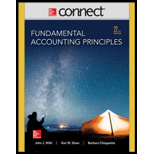
Concept explainers
Concept Introduction:
Petty Cash Accounting: Petty Cash is a small amount of cash kept for disbursing small expenses like postage, miscellaneous expenses etc. in this system an amount of cash is given to a custodian as advance to disburse for expenses. The custodian disburses the expenses and asks for replenishment or raising the fund time to time. The following transactions are incurred in case of petty cash system:
- Establishment of the petty cash fund: Petty cash is created by drawing amount of cash from business as a separate account. To journalize this transaction, the Petty cash account is debited and Cash account is credited with the initial amount of petty cash fund.
- Disbursements from the petty cash fund: The custodian disburses the find for payment of small expenses. Each disbursement is not recorded separately; rather a combined
journal entry is passed at the time of replenishment of the fund.
- Replenishment for the petty cash fund: The fund is replenished with the amount of cash spent to bring the find balance same as the initial fund.
- Increase or Decrease of fund amount: Petty Cash fund amount may be increased or decreased as per the requirements. To increase the fund, the Petty cash account is debited and Cash account is credited. To Decrease the fund, Cash account is debited and Petty cash account.
Requirement-1:
To prepare: The Journal entries for the establishment of the petty cash fund
Requirement-2:
To prepare: The Petty Cash payments report for the month of February
Requirement-3(a):
To prepare: The journal entry for the replenishment of the petty cash fund
Requirement-3(b):
To prepare: The journal entry for the increase in the petty cash fund
Want to see the full answer?
Check out a sample textbook solution
Chapter 8 Solutions
FUND.ACCT.PRIN -ONLINE ONLY >I<
- A trial balance includes:A. Only revenue and expense accountsB. All accounts with balancesC. Only permanent accountsD. Only assets and liabilitiesarrow_forwardThe matching principle helps ensure:A. Revenues are equal to expensesB. Revenues and related expenses are recorded in the same periodC. Cash is matched to liabilitiesD. Accounts match physical inventoryneed helparrow_forwardThe matching principle helps ensure:A. Revenues are equal to expensesB. Revenues and related expenses are recorded in the same periodC. Cash is matched to liabilitiesD. Accounts match physical inventoryarrow_forward
- No Ai A trial balance includes:A. Only revenue and expense accountsB. All accounts with balancesC. Only permanent accountsD. Only assets and liabilitiesarrow_forwardWhich account is increased with a credit?A. CashB. Salaries ExpenseC. Accounts ReceivableD. Service Revenue need helparrow_forwardNo AI A trial balance includes:A. Only revenue and expense accountsB. All accounts with balancesC. Only permanent accountsD. Only assets and liabilitiesarrow_forward
- I need help with this general accounting problem using proper accounting guidelinesarrow_forwardHello Needed Answer of Financial Accounting Question with Correct Methodarrow_forwardNo AI Which account is increased with a credit?A. CashB. Salaries ExpenseC. Accounts ReceivableD. Service Revenuearrow_forward

 AccountingAccountingISBN:9781337272094Author:WARREN, Carl S., Reeve, James M., Duchac, Jonathan E.Publisher:Cengage Learning,
AccountingAccountingISBN:9781337272094Author:WARREN, Carl S., Reeve, James M., Duchac, Jonathan E.Publisher:Cengage Learning, Accounting Information SystemsAccountingISBN:9781337619202Author:Hall, James A.Publisher:Cengage Learning,
Accounting Information SystemsAccountingISBN:9781337619202Author:Hall, James A.Publisher:Cengage Learning, Horngren's Cost Accounting: A Managerial Emphasis...AccountingISBN:9780134475585Author:Srikant M. Datar, Madhav V. RajanPublisher:PEARSON
Horngren's Cost Accounting: A Managerial Emphasis...AccountingISBN:9780134475585Author:Srikant M. Datar, Madhav V. RajanPublisher:PEARSON Intermediate AccountingAccountingISBN:9781259722660Author:J. David Spiceland, Mark W. Nelson, Wayne M ThomasPublisher:McGraw-Hill Education
Intermediate AccountingAccountingISBN:9781259722660Author:J. David Spiceland, Mark W. Nelson, Wayne M ThomasPublisher:McGraw-Hill Education Financial and Managerial AccountingAccountingISBN:9781259726705Author:John J Wild, Ken W. Shaw, Barbara Chiappetta Fundamental Accounting PrinciplesPublisher:McGraw-Hill Education
Financial and Managerial AccountingAccountingISBN:9781259726705Author:John J Wild, Ken W. Shaw, Barbara Chiappetta Fundamental Accounting PrinciplesPublisher:McGraw-Hill Education





